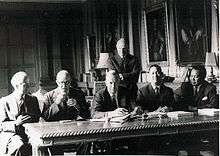Cobbold Commission
| Report of the Commission of Enquiry, North Borneo and Sarawak, 1962 | |
|---|---|
| Created | 17 January 1962 |
| Ratified | 21 June 1962 |
| Location |
The National Archives, Kew, Richmond, Surrey TW9 4DU, United Kingdom |
| Author(s) | The Commission of Enquiry, North Borneo and Sarawak, 1961-1962 |
| Signatories |
|
| Purpose | The formation of Malaysia, 1961 - 1963 |
The Cobbold Commission, was a Commission of Enquiry set up to determine whether the people of North Borneo (now Sabah) and Sarawak supported the proposal to create the Federation of Malaysia consisting of Malaya, Brunei, Singapore, North Borneo, and Sarawak.[1][2] It was also responsible for the subsequent drafting of the Constitution of Malaysia prior to the formation of Malaysia on 16 September 1963.[3] The Commission was headed by former Bank of England governor, Lord Cobbold.
Members

Members of the Commission were:
- Lord Cobbold, former Governor of the Bank of England, chairman of the Commission
- Wong Pow Nee, Chief Minister of Penang,
- Ghazali Shafie, Permanent Secretary to the Ministry of Foreign Affairs
- Anthony Abell, former Governor of Sarawak
- David Watherston, former Chief Secretary Of Malaya.
Report
The Commission released its findings, report and recommendations on 1 August 1962. It concluded that the formation of Malaysia should be implemented. However, Lord Cobbold also stressed that all parties enter the federation as equal partners. The findings were summarised by Lord Cobbold as follows:
About one-third of the population of each territory strongly favours early realisation of Malaysia without too much concern about terms and conditions. Another third, many of them favourable to the Malaysia project, ask, with varying degrees of emphasis, for conditions and safeguards varying in nature and extent: the warmth of support among this category would be markedly influenced by a firm expression of opinion by Governments that the detailed arrangements eventually agreed upon are in the best interests of the territories. The remaining third is divided between those who insist on independence before Malaysia is considered and those who would strongly prefer to see British rule continue for some years to come. If the conditions and reservations which they have put forward could be substantially met, the second category referred to above would generally support the proposals. Moreover once a firm decision was taken quite a number of the third category would be likely to abandon their opposition and decide to make the best of a doubtful job. There will remain a hard core, vocal and politically active, which will oppose Malaysia on any terms unless it is preceded by independence and self-government: this hard core might amount to near 20 per cent of the population of Sarawak and somewhat less in North Borneo.— Lord Cobbold, Cobbold Commission
Table of Content
| Wikisource has original text related to this article: |
- COMPOSITION OF THE COMMISSION
- TERM OF REFERENCE
- INTRODUCTION
- 1. ENQUIRY IN SARAWAK
- 2. ENQUIRY IN NORTH BORNEO
- 3. ASSESSMENT OF EVIDENCE
- 4. Recommendations
- A—Recommendations on certain general matters
- B—Recommendations by Sir Anthony Abell and Sir David Watherston
- C—Recommendations by Dato Wong Pow Nee and Enche Mohammed Ghazali bin Shafie
- D—Summary of Recommendations in Sections B and C, and Comments, by the Chairman
- 5. OTHER MATTERS
- 6. THANKS AND ACKNOWLEDGEMENTS
- Appendices
- A. Itinerary
- B. Census Abstract
- C. Cardinal Principles of the rule of the English Rajah
- D. Legal Meaning of the Term "Native"
- E. North Borneo and Sarawak Governments Papers on Malaysia
- F. "Memorandum on Malaysia" Submitted by the Malaysia Solidarity Consultative Committee
- Map of the Borneo Territories
See also
| Wikimedia Commons has media related to Cobbold Commission. |
- 18-point agreement (Sarawak)
- 20-point agreement (Sabah)
- Reid Commission
- Nine Cardinal Principles of the rule of the English Rajah
References
- ↑ Malaysia and the non-fulfilment of two agreements with Sabah and Sarawak - Tengku Razaleigh Hamzah
- ↑ The call for a review of the safeguards for Sabah and Sarawak and their status as equal partners to Malaya by Tengku Razaleigh Hamzah needs to be brought up in parliament.
- ↑ "No.10760: Agreement relating to Malaysia" (pdf). United Nations Treaty Collection. United Nations. July 1963. Retrieved 2010-07-29.
External links
- Report of the Commission of Enquiry, North Borneo and Sarawak, 1962 (full report)
- UN General Assembly 15th Session - The Trusteeship System and Non-Self-Governing Territories (pages:509-510)
- UN General Assembly 18th Session - the Question of Malaysia (pages:41-44)

